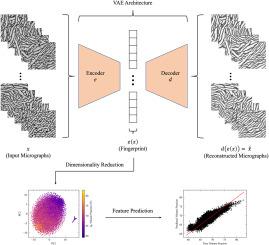当前位置:
X-MOL 学术
›
Comp. Mater. Sci.
›
论文详情
Our official English website, www.x-mol.net, welcomes your feedback! (Note: you will need to create a separate account there.)
Exploring descriptors for titanium microstructure via digital fingerprints from variational autoencoders
Computational Materials Science ( IF 3.3 ) Pub Date : 2024-04-09 , DOI: 10.1016/j.commatsci.2024.112992 Michael D. White , Gowtham Nimmal Haribabu , Jeyapriya Thimukonda Jegadeesan , Bikramjit Basu , Philip J. Withers , Chris P. Race
Computational Materials Science ( IF 3.3 ) Pub Date : 2024-04-09 , DOI: 10.1016/j.commatsci.2024.112992 Michael D. White , Gowtham Nimmal Haribabu , Jeyapriya Thimukonda Jegadeesan , Bikramjit Basu , Philip J. Withers , Chris P. Race

|
Microstructure is key to controlling and understanding the properties of materials, but traditional approaches to describing microstructure capture only a small number of features. We require more complete descriptors of microstructure to enable data-centric approaches to materials discovery, to allow efficient storage of microstructural data and to assist in quality control in metals processing. The concept of , using machine learning (ML) to develop quantitative, low-dimensional descriptors of microstructures, has recently attracted significant attention. However, it is difficult to interpret conclusions drawn by ML algorithms, which are often referred to as “black boxes”. For example, convolutional neural networks (CNNs) can be trained to make predictions about a material from a set of microstructural image data, but the feature space that is learned is often used uncritically and adopted without any validation.
中文翻译:

通过变分自动编码器的数字指纹探索钛微结构的描述符
微观结构是控制和理解材料性能的关键,但描述微观结构的传统方法仅捕获少量特征。我们需要更完整的微观结构描述符,以实现以数据为中心的材料发现方法,允许有效存储微观结构数据并协助金属加工的质量控制。使用机器学习 (ML) 开发微观结构的定量、低维描述符的概念最近引起了广泛关注。然而,机器学习算法得出的结论很难解释,通常被称为“黑匣子”。例如,可以训练卷积神经网络(CNN)根据一组微观结构图像数据对材料进行预测,但所学习的特征空间通常不加批判地使用,并且在没有任何验证的情况下被采用。
更新日期:2024-04-09
中文翻译:

通过变分自动编码器的数字指纹探索钛微结构的描述符
微观结构是控制和理解材料性能的关键,但描述微观结构的传统方法仅捕获少量特征。我们需要更完整的微观结构描述符,以实现以数据为中心的材料发现方法,允许有效存储微观结构数据并协助金属加工的质量控制。使用机器学习 (ML) 开发微观结构的定量、低维描述符的概念最近引起了广泛关注。然而,机器学习算法得出的结论很难解释,通常被称为“黑匣子”。例如,可以训练卷积神经网络(CNN)根据一组微观结构图像数据对材料进行预测,但所学习的特征空间通常不加批判地使用,并且在没有任何验证的情况下被采用。



























 京公网安备 11010802027423号
京公网安备 11010802027423号